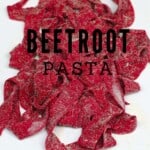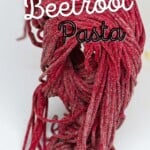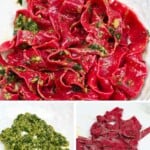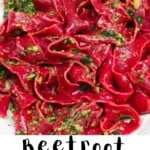This post may contain affiliate links. Please read our disclosure policy.
How to make beet pasta (aka pink pasta) at home with just 3 ingredients. This beetroot pasta is dairy-free, egg-free, with a subtle earthy flavor and bright pink color – perfect for impressing with your next pasta meal!
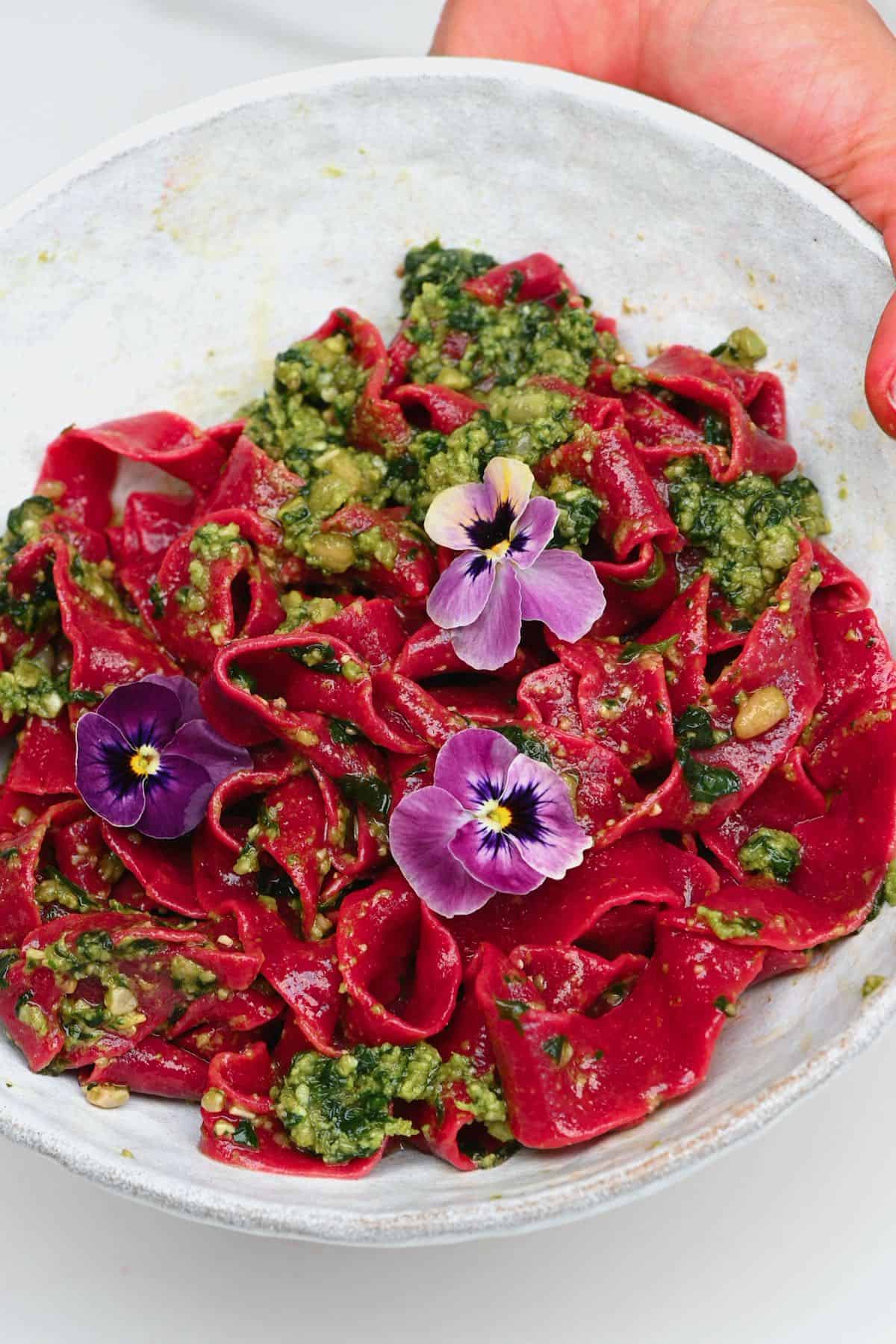
Okay, I’ll admit it – I’m officially obsessed with pasta. I’ve already shared a regular egg pasta, red lentil pasta, oat pasta, and chickpea pasta. Most recently, I also shared a post for nutritious green spinach pasta. Now, it’s the turn of this homemade beet pasta!
By using beet juice in place of another liquid for this vegan pasta dough, you’re able to make a bright Fuschia pasta dough that cooks up wonderfully with a subtle earthy beet flavor. Best of all, not only does it look great, but it’s a great way to get veggie-wary kids to eat more veggies.
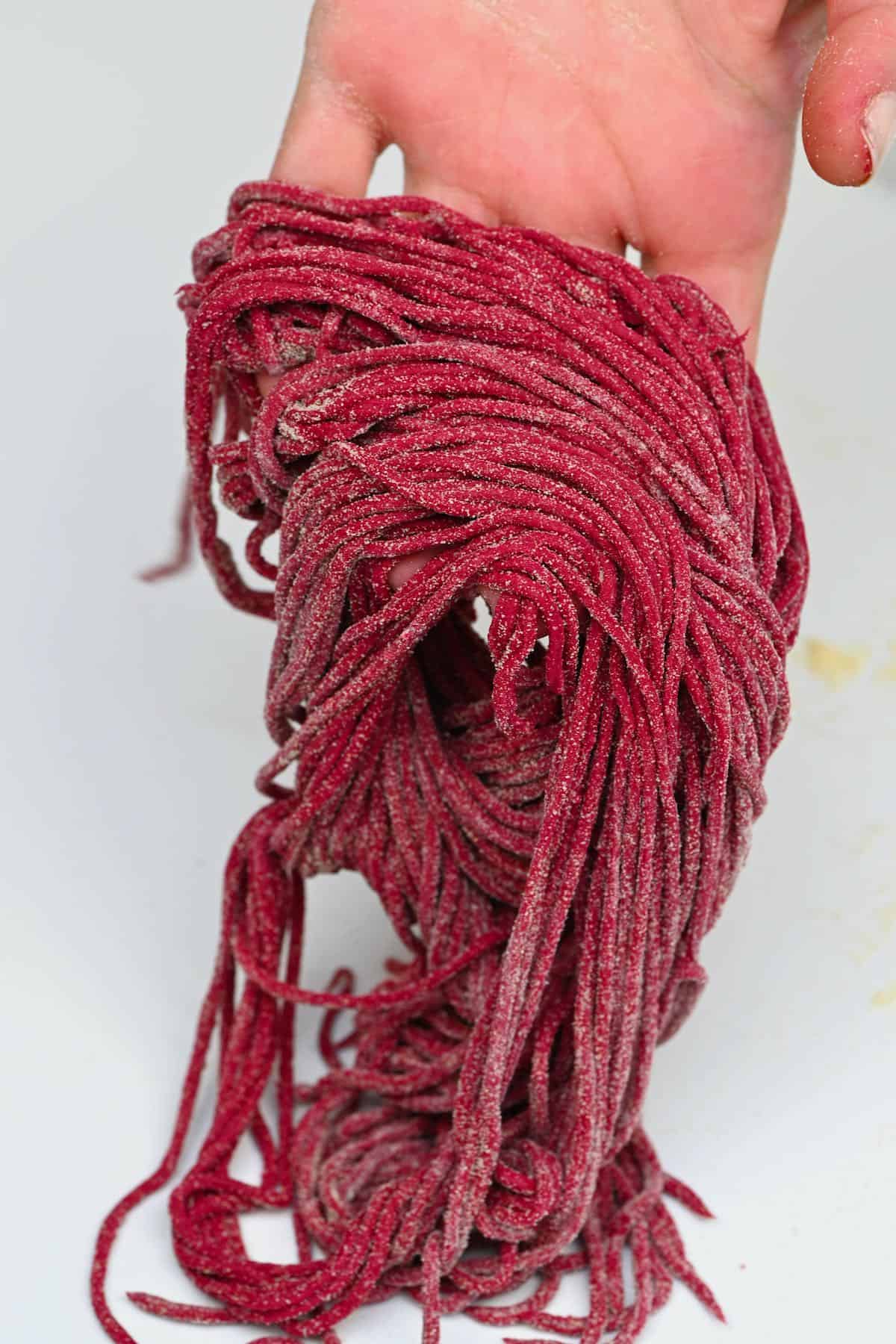
Use this beet pasta in place of regular pasta for all your favorite dishes, and it’s sure to impress. Even better, you can use this beet pasta recipe to create pink noodles, lasagna sheets, and various types of shapes and extruded pasta.
Once rolled out and shaped, cook the pasta immediately, store it in the fridge or freezer, or even dry it for long-term storage!
And if you enjoy beets as much as I do (they add a lovely pop of color to your table), you might also like this beet soup recipe, beet hummus, or quick pickled beets.
Want to save this recipe?
The Ingredients
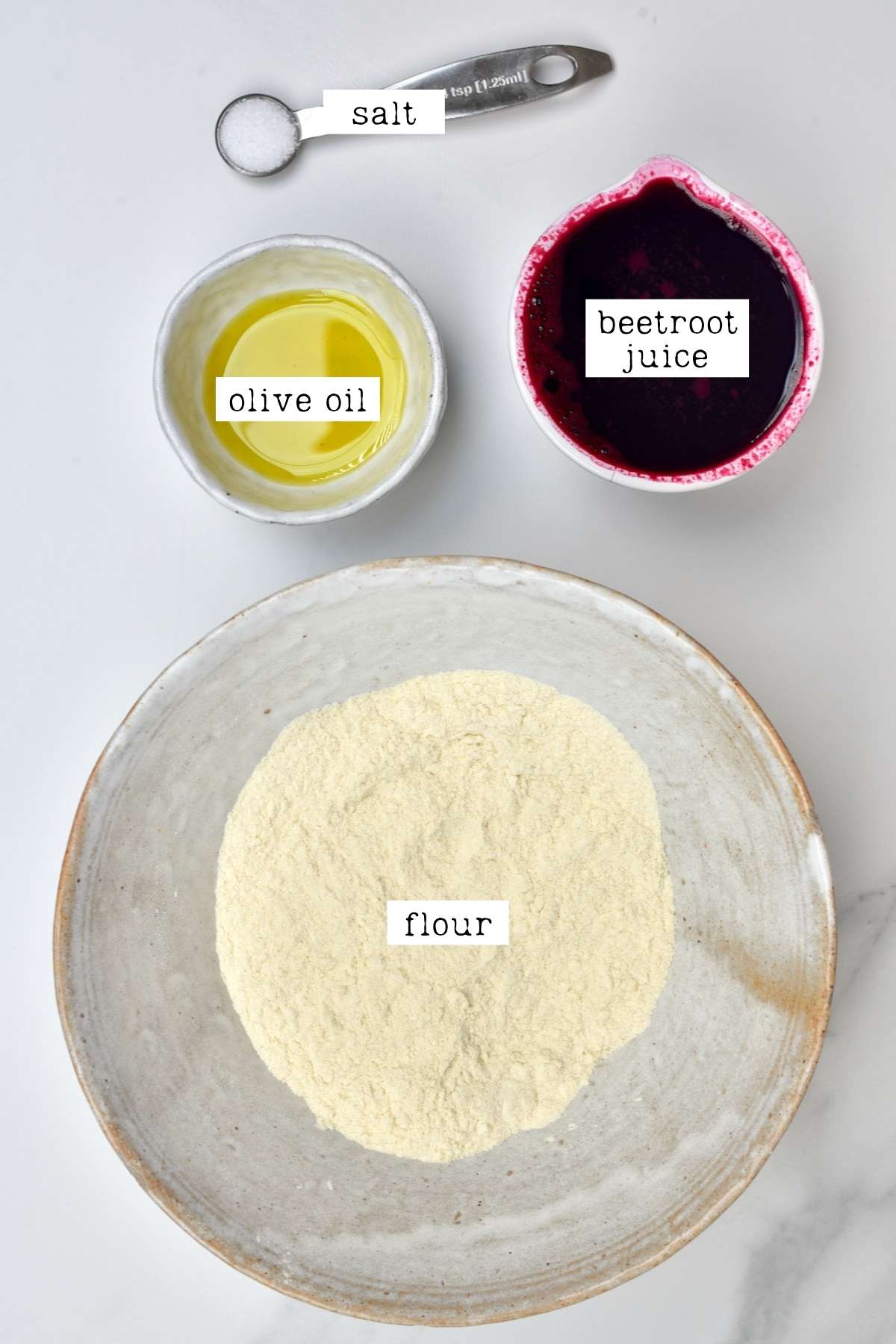
- Beetroot: if you have a juicer, then you can use fresh beetroot. Otherwise, use bottled beetroot juice (try to choose one without too many extra add-ins). Check the FAQs on using beet puree.
- Flour: I used 00 flour for this beet pasta recipe. However, you could use all-purpose flour (which will yield slightly chewier pasta) or a combination of 00 flour and semolina flour (which will create a stronger dough).
- Olive oil: olive oil will help to yield beet pasta dough that is more tender and supple. This makes it easier to roll and shape (which is important with an egg-free recipe).
- Salt: just a little to help season the dough and provide a more balanced flavor.
How to Make Beet Pasta
Step 1: Prepare the beetroot juice
If you bought beetroot juice, then skip this step. Otherwise, chop the beetroot into small enough pieces to fit your juicer chute and juice it.
Read the FAQs on how to use beet puree instead!
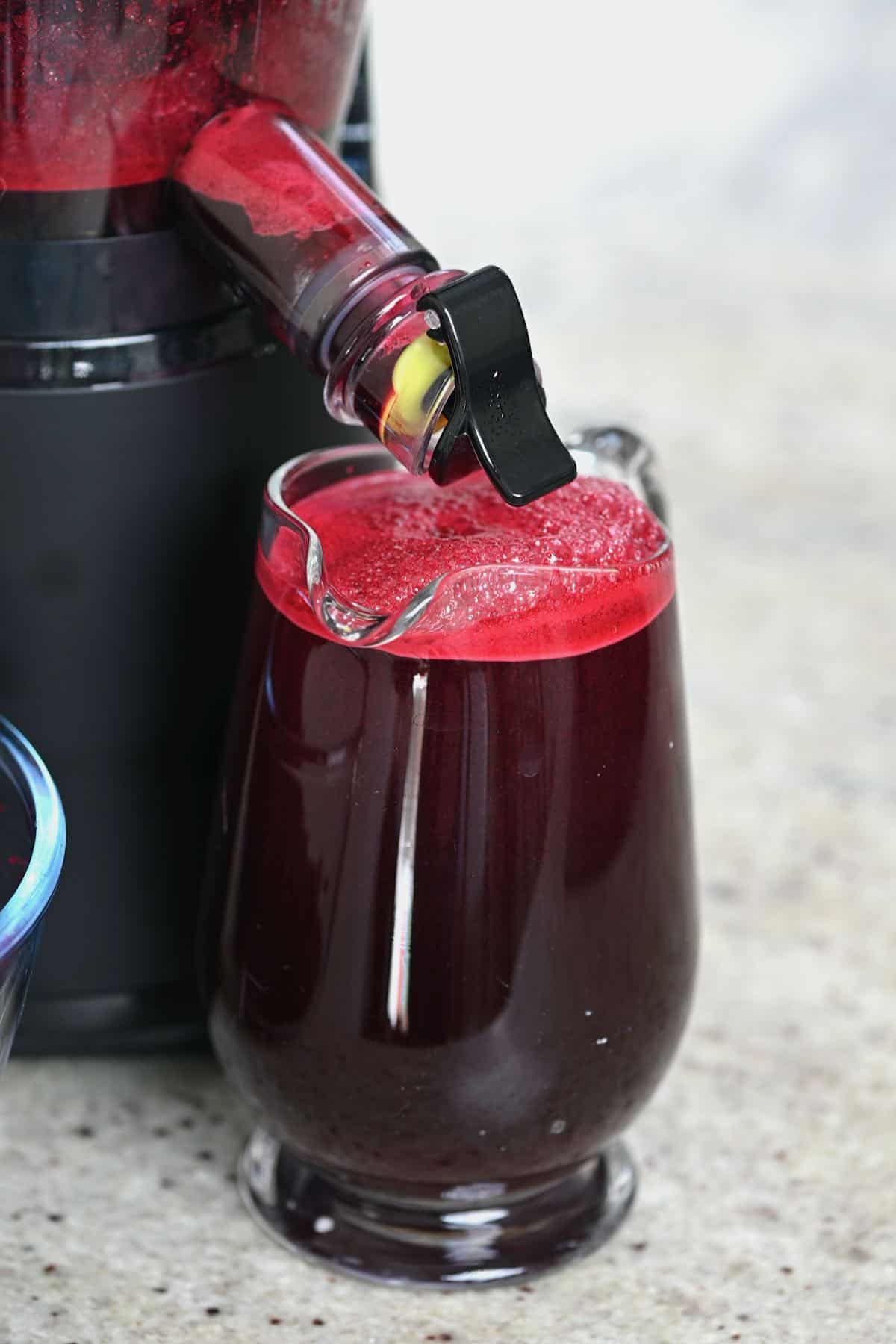
Step 2: Prepare the pink pasta dough
Add the flour to your clean working surface, create a well in the center, and then add the beet juice and oil to the center of the well.
Make sure not to do this on a surface that stains easily, as beetroot juice can (and will) stain! You can also do this in a large bowl.
Use a fork or small spatula to mix from the center outwards, incorporating the ingredients into a ‘shaggy’ dough.
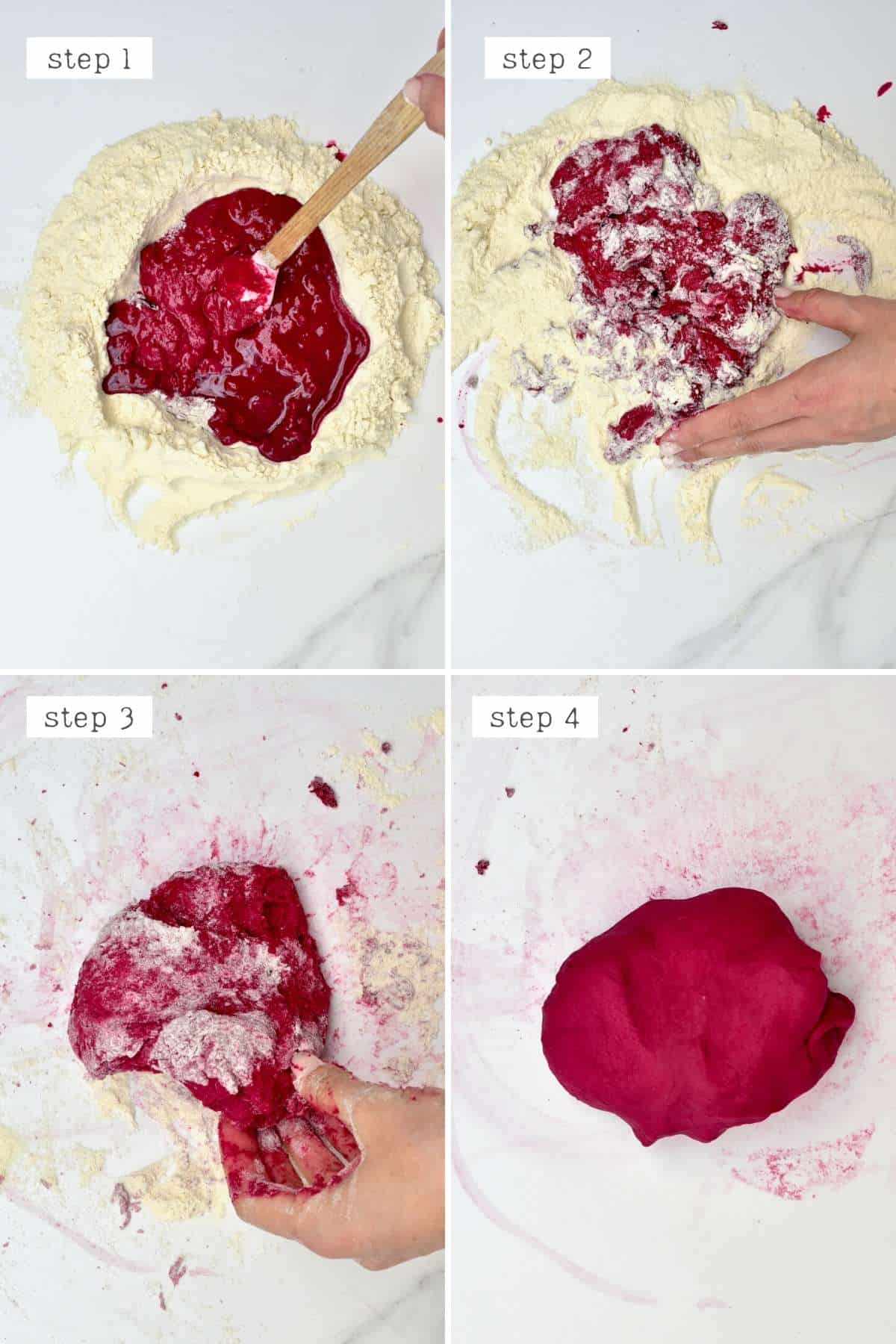
Then, use your hands to knead the dough until smooth. This will take around 10 minutes.
You could alternatively do this process in a stand mixer with a dough hook. Start on the lowest setting and increase once it reaches shaggy dough. Mix until the dough is smooth and supple.
If the pink pasta dough is a little too wet (i.e., it sticks to your hands), then add a little more flour (just a tsp at a time). Then knead until smooth.
It’s okay if it’s slightly sticky, as the juice will take some time to absorb into the dough properly. However, if it’s still a little sticky after resting (next step), then you’ll need to add a little more flour.
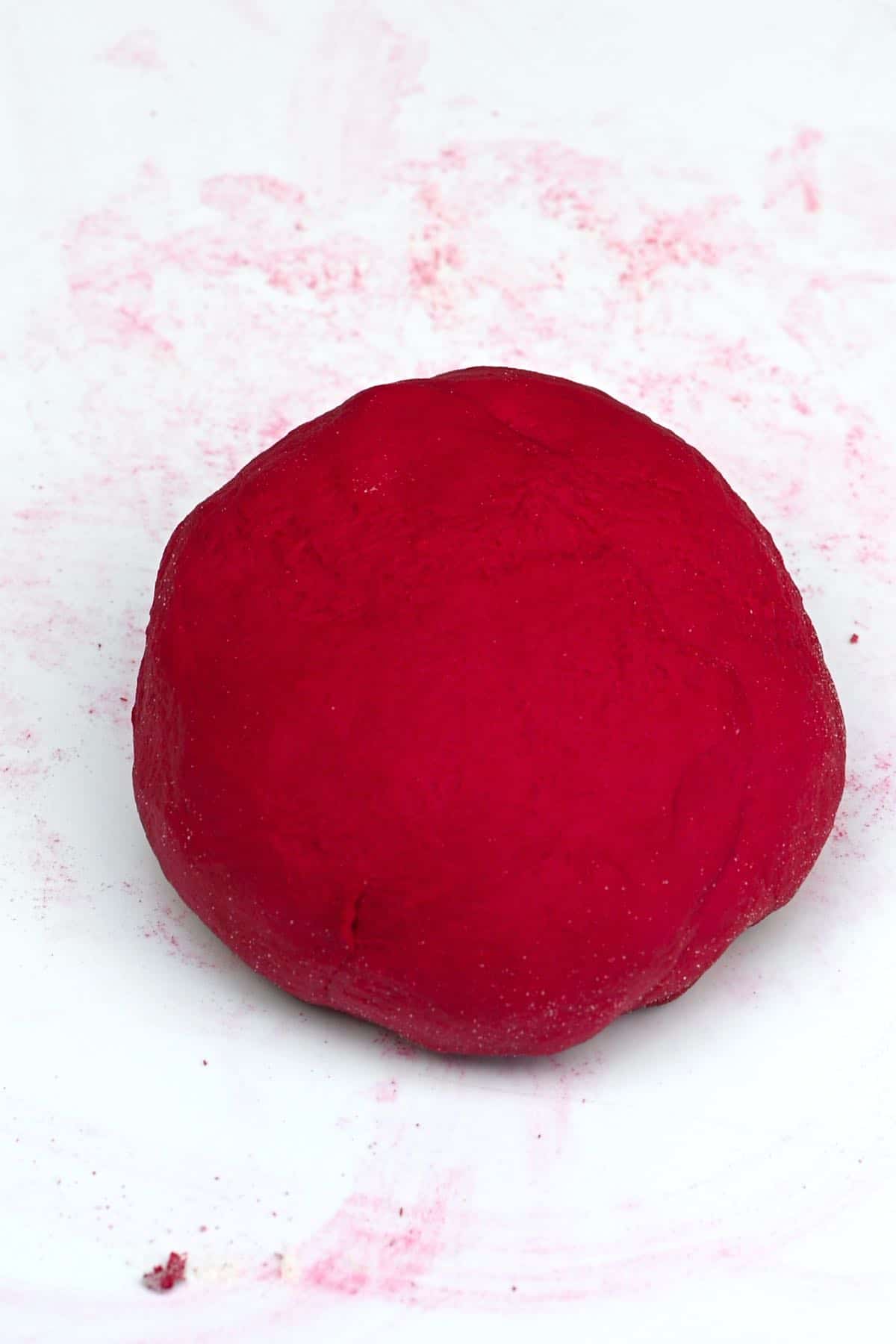
Step 3: Allow the dough to rest
Wrap the pink pasta dough in plastic wrap tightly and allow it to rest for 30 minutes in the refrigerator. During this time, the gluten will relax – ready for when you roll and shape the dough. If it isn’t ready, then the dough will spring back into shape.
Step 4: Roll and shape the dough
Once the beet pasta dough is rested, it’s time to divide it into more manageable pieces. I tend to separate mine into four pieces. Use a sharp knife or bench scraper to cut the dough ball into rough quarters.
Working on one section at a time, cover the remaining pieces with clingfilm to stop them from drying out.
Next, it’s time to roll out the pasta dough. You can do this by hand or using a pasta machine. If you want to make pasta shapes like penne or spaghetti noodles, you can even skip the rolling altogether and use a pasta extruder.
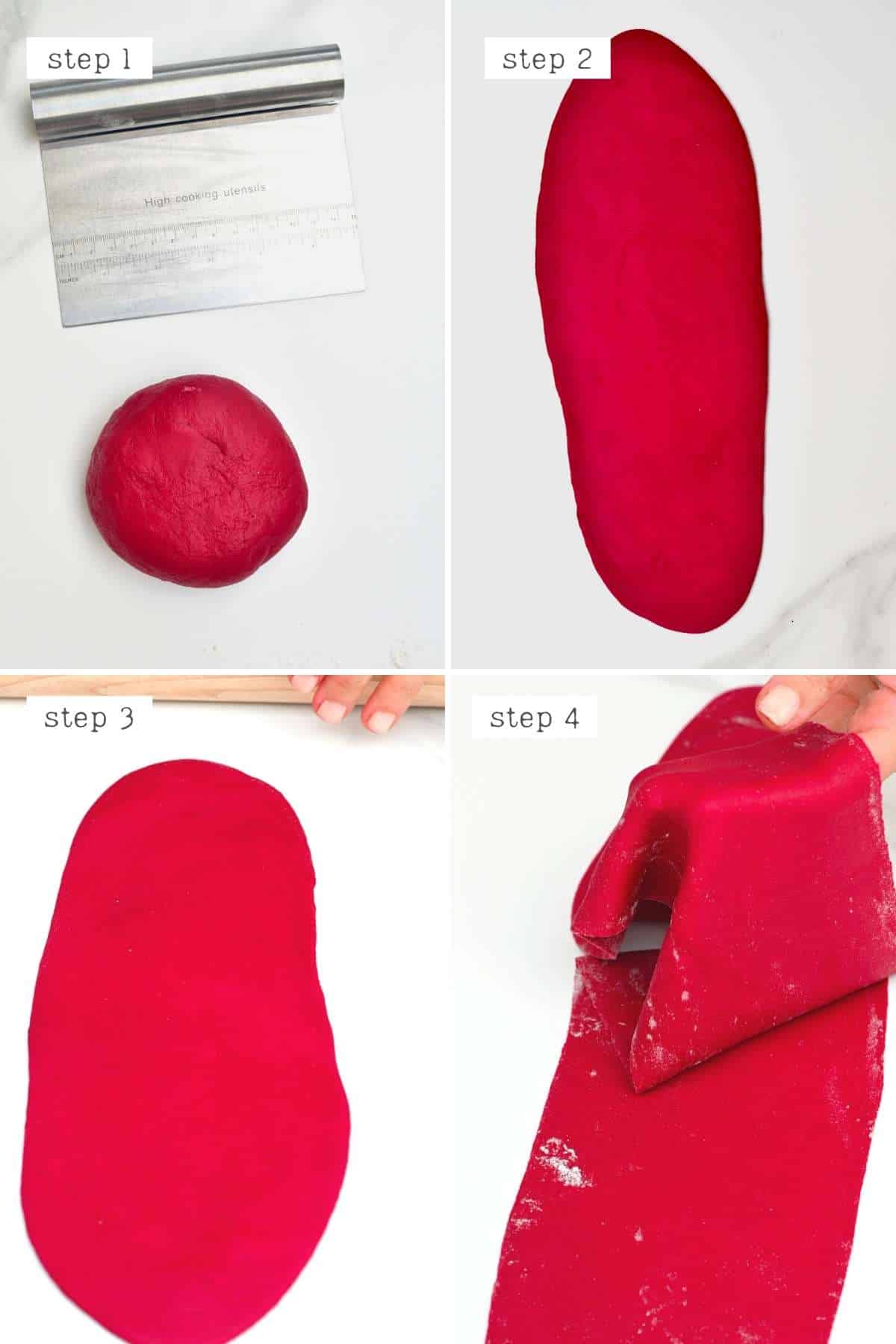
To roll by hand
Dust the surface with semolina or flour and then, using a rolling pin, roll the dough out to around 2-3mm. If the dough starts to stick to the rolling pin, dust the dough’s surface with more semolina/flour.
Once rolled out, sprinkle the beet pasta with a little more semolina/flour and then cut to your desired shape: lasagna sheets, bows, ravioli, or noodles like fettuccine, ribbons, pappardelle, etc.
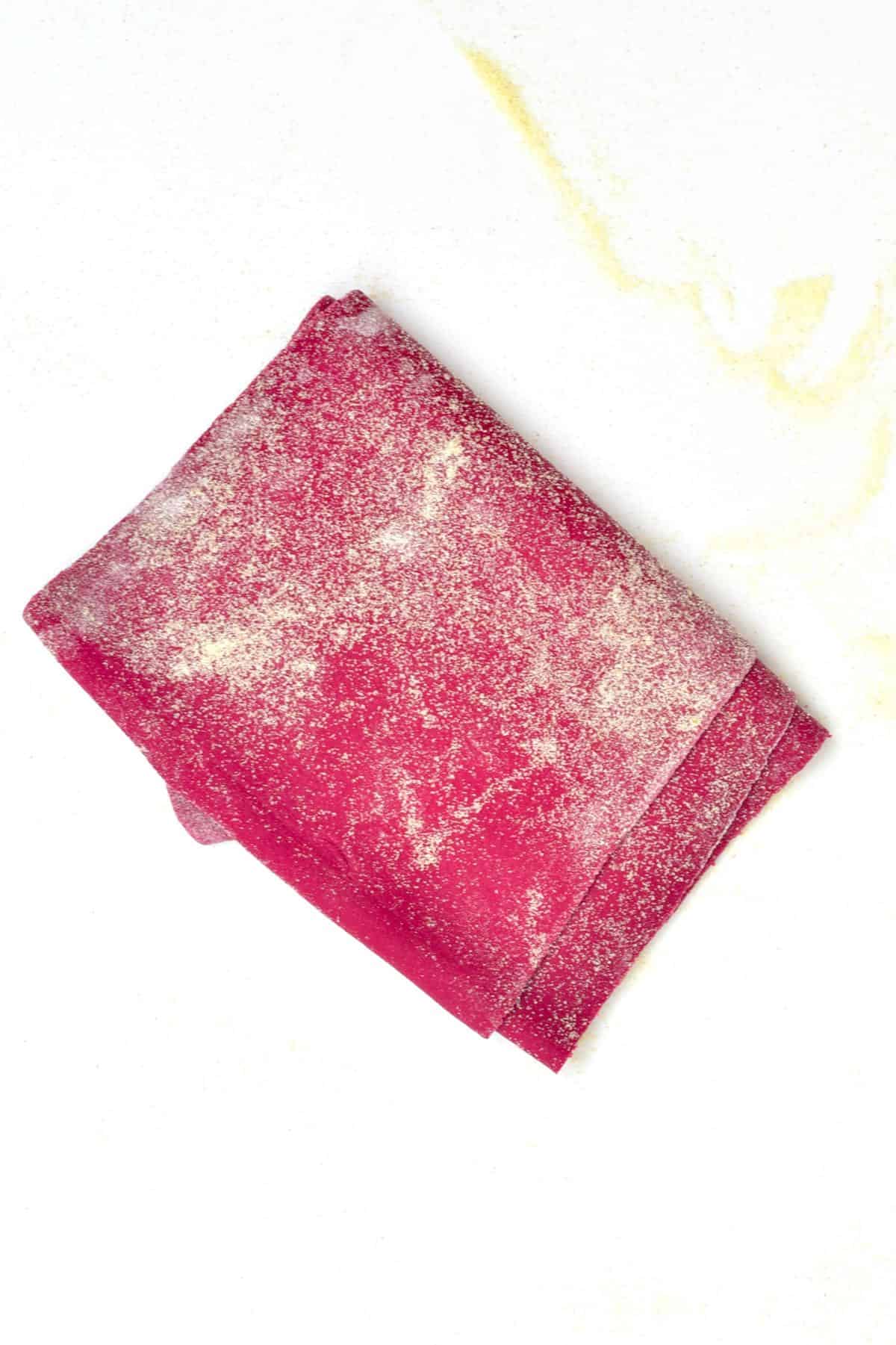
To hand cut the noodles, loosely roll the pasta dough, trim the ends, and then use a sharp knife to chop the noodles to your desired width. Once cut, toss with a little more flour/semolina, so the noodles don’t stick together.
Store any cut pasta under a clean kitchen towel and repeat this step with the remaining dough portions.
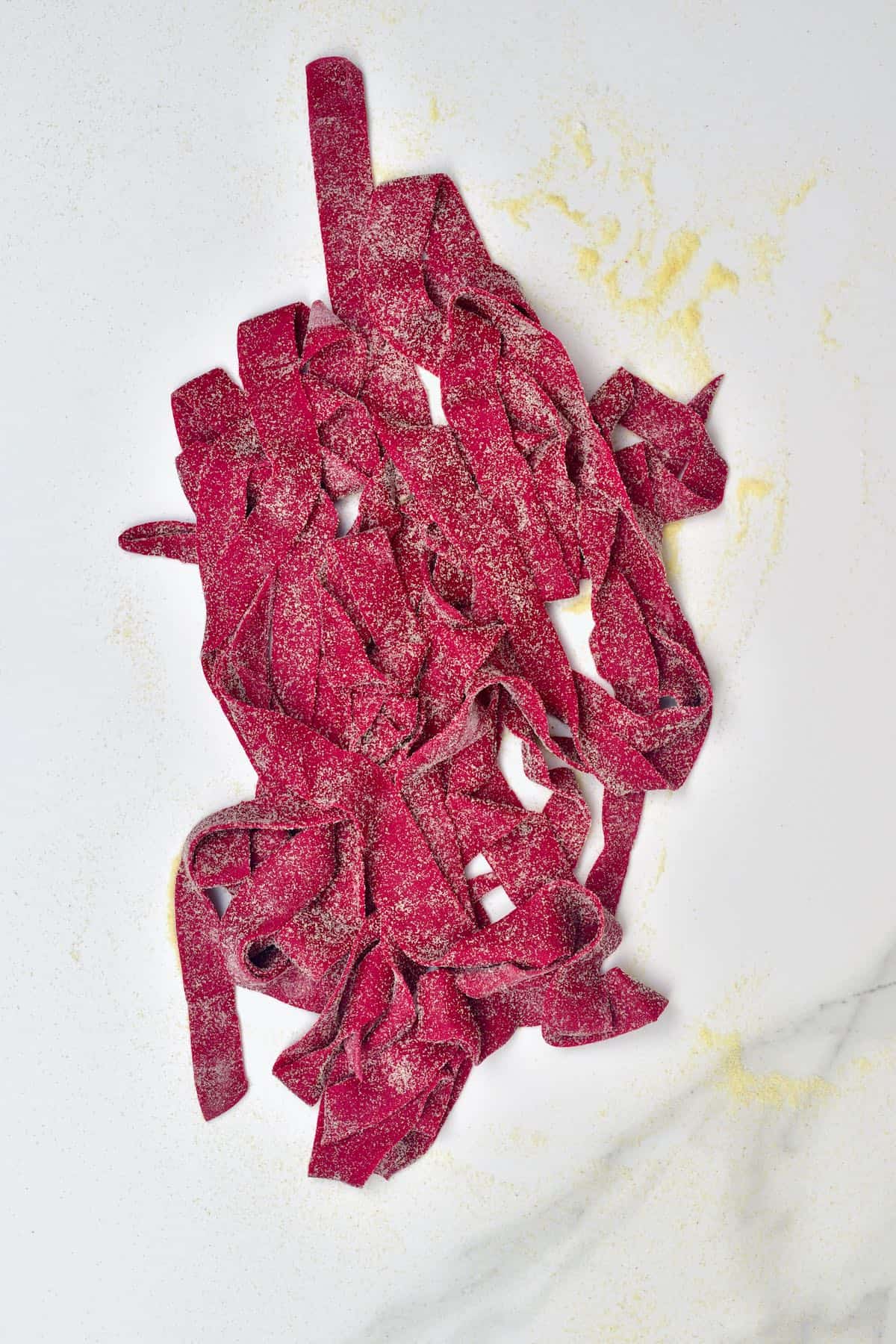
To use a pasta machine
Using one section of the beetroot pasta dough at a time, flatten it just enough to fit the widest setting of your pasta machine – sprinkle generously with semolina/flour.
Then, feed the beet dough through the machine, fold it like a letter, and re-feed it through the machine a further three times.
Then, continue to feed the dough through the machine, working your way through the settings one at a time until you reach the desired dough thickness. Make sure to sprinkle the dough with flour/semolina well, to stop it from sticking to the machine.
Once the beet pasta dough is rolled out, you can use your pasta machine attachments (for spaghetti/noodles) or cut the shapes by hand. Then repeat with the remaining dough.
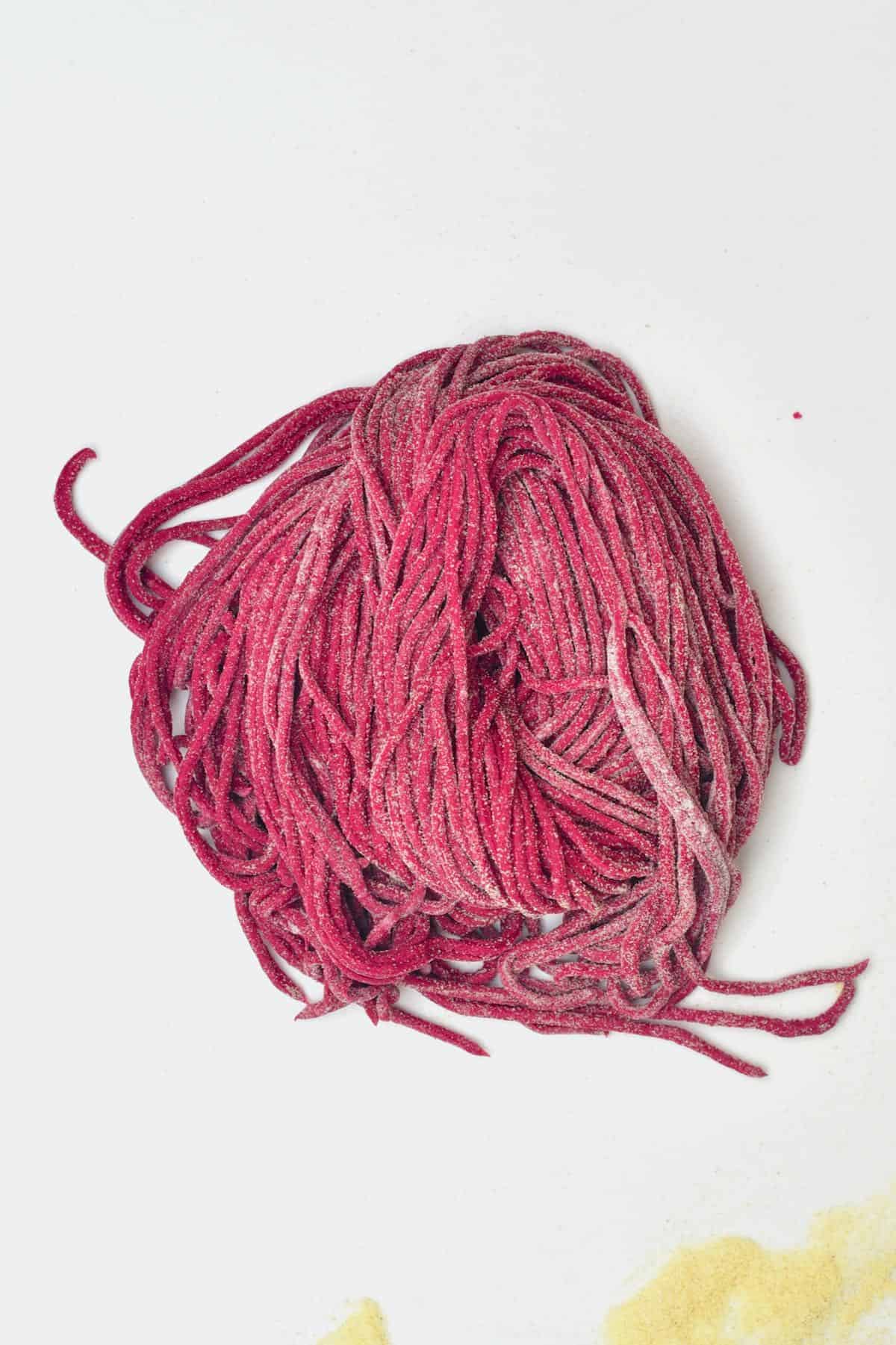
Step 5: Cook the pasta
After you’ve rolled and shaped all the dough, you can either cook the beet pasta immediately or dry it to store for later (read below).
To cook the beet pasta, bring a pot of salted water to a boil, then carefully add the beetroot pasta and cook for 2-3 minutes, stirring occasionally. This may take slightly less/longer based on how thick the pasta is.
If you’re cooking the pasta from frozen or dried, you’ll need to add an extra 1-3 minutes. Once ready, drain and serve with the sauce of your choice! This time, I used homemade pesto. Herby butter and sauces with cheese also work particularly well with beet pasta.
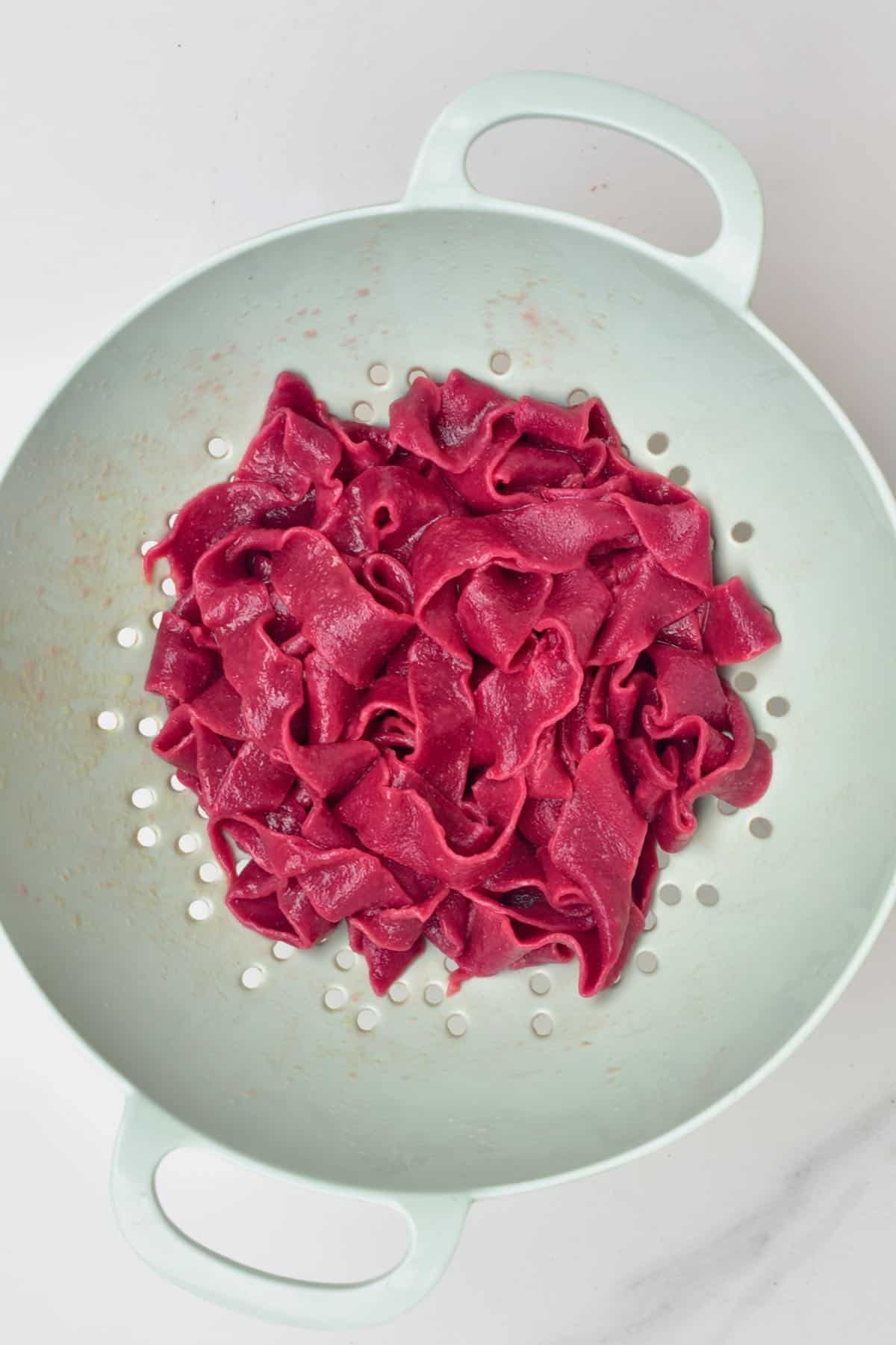
How to Dry and Store Beet Pasta
To dry: to dry the pink noodles, you can form them into nests and dry them either in a dehydrator or at room temperature for several hours (or longer, depending on the humidity and temperature). They are ready when the pasta ‘snaps’ rather than bends. Once dry, you can store the beetroot pasta for several months in an airtight container.
Fridge: store the pasta in an airtight container, sprinkled with lots of flour to avoid sticking, and use it within two days. The sooner, the better!
Freeze: you can freeze the beet pasta together or form it into “nests”/individual portions (my preferred choice). Make sure to sprinkle with extra flour. If you form into nests, then allow them to freeze on a tray before storing them in an airtight container for 2-3 months. You can freeze the dried pasta for up to 6 months.
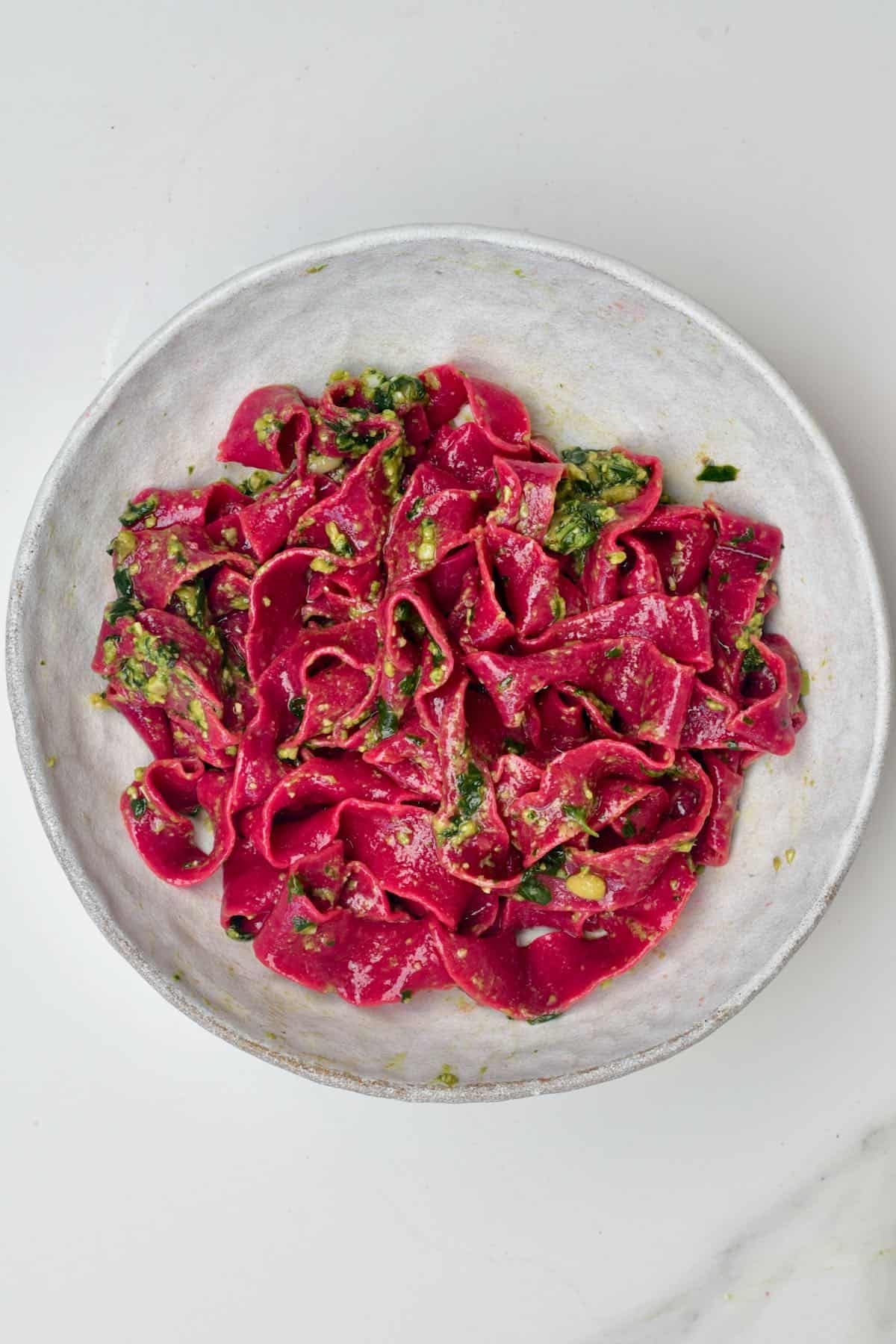
FAQs
Yes, you actually can. Feel free to use boiled and blended beetroot – just make sure it’s blended into a smooth puree. You can also use roasted beetroot – which will provide a slightly different flavor to the beet pasta recipe. Roast the beet alone or with herbs (then remove before pureeing) for additional layers of flavor.
Yes, to both! While it’s traditional to prepare this pink pasta recipe (and any pasta) on a clean surface, it’s perfectly fine to use a different method (especially when using a product that stains as much as beet does). If using a stand mixer, you may even have a pasta machine attachment which you can use.
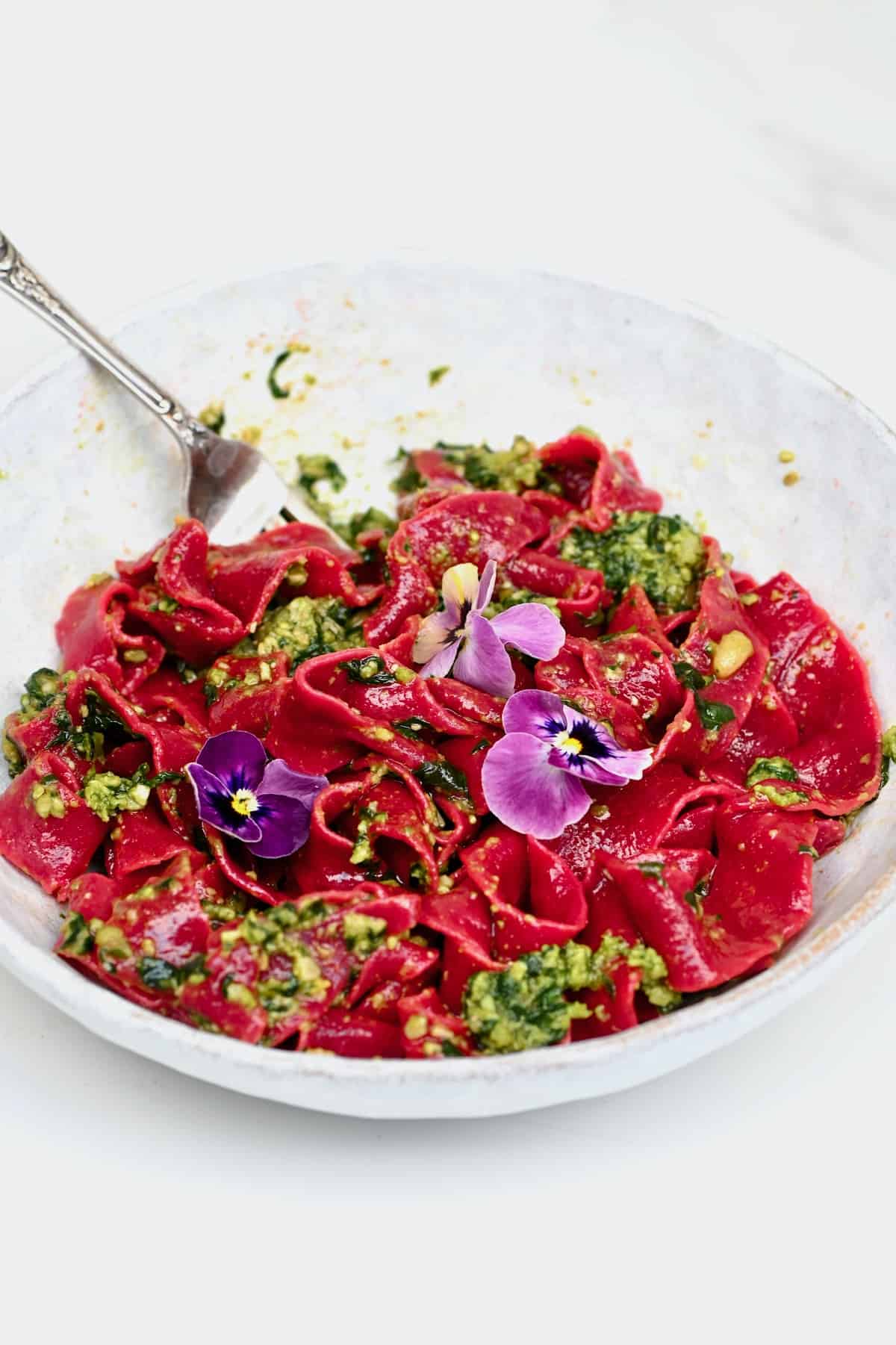
Recipe Notes & Variations
- The correct liquid to flour ratio: though I’ve advised the exact amount of juice vs. flour that worked for me, this can differ minimally between batches based on temperature, climate, the flour, etc. Keep some extra juice/flour to one side, just in case.
- For beet ravioli: feel free to prepare the pasta dough into filled beet ravioli/ tortellini. If doing so, you can freeze the pasta for up to one month. Alternatively, use it fresh within a day.
- The color of the pasta: the color of the pink pasta can change upon cooking the pasta. I’ve found it holds the color REALLY well. However, it can leech into the water and become lighter or even orange-ish in tone.
- Add herbs: for more flavor, feel free to add some dried herbs to the pasta dough. Dried herbs mean you’ll get a speckled effect in the dough without any color leeching.
- The strength of the dough: because this pasta is egg-free, the dough isn’t quite as strong as it otherwise would be, so be gentle when handling it.
- For more advice and FAQ answers, you can check out my posts for egg pasta and homemade vegan pasta.
Other Homemade Pasta Recipes
- Fresh Home-made Spinach Green Pasta (egg pasta)
- How to Make Spinach Noodles (egg-free)
- Easy Homemade Potato Gnocchi
- How to Make Chickpea Flour Pasta
- Homemade Vegan Pasta
- All-Natural Homemade Rainbow Pasta
- How to Make Oat pasta (3 Ingredient Gluten-free Pasta)
If you try this pink beetroot pasta recipe, I’d love to hear your thoughts/questions below. Also, I’d appreciate a recipe card rating below, and feel free to tag me in your recipe recreations on Instagram @Alphafoodie!

How to Make Beet Pasta (Pink Pasta Recipe)
Ingredients
- 1/2 cup beetroot juice or puree (see FAQs)
- 7 oz 00 flour or all-purpose
- 2 Tbsp olive oil
- 1/4 tsp salt
Instructions
Step 1: Prepare the beetroot juice
- If you bought beetroot juice, then skip this step. Otherwise, chop the beetroot into small enough pieces to fit your juicer chute and juice it.
Step 2: Prepare the pink pasta dough
- Add the flour to your clean working surface, create a well in the center, and then add the beet juice and oil to the center of the well.Make sure not to do this on a surface that stains easily, as beetroot juice can (and will) stain! Alternatively, you can mix the ingredients in a bowl.
- Use a fork or small spatula to mix from the center outwards, incorporating the ingredients into a ‘shaggy’ dough.
- Use your hands to knead the dough until smooth. This will take around 10 minutes.You could alternatively do this process in a stand mixer with a dough hook. Start on the lowest setting and increase once it reaches shaggy dough. Mix until the dough is smooth ad supple.
- If the pink pasta dough is a little too wet (i.e., it sticks to your hand a lot), then add a little more flour (just a tsp at a time). Then knead until smooth.It’s okay if it’s slightly 'tacky', though, as the juice will take some time to absorb into the dough properly. However, if it’s still a little sticky after resting (next step), then you’ll need to add a little more flour.
Step 3: Allow the dough to rest
- Wrap the pink pasta dough in plastic wrap tightly and allow it to rest for 20-30 minutes in the refrigerator. During this time, the gluten will relax – ready for when you roll and shape the dough. If it isn’t ready, then the dough will spring back into shape.
Step 4: Roll and shape the dough
- Once the beet pasta dough is rested, it’s time to divide it into more manageable pieces. I tend to separate mine into four pieces. Use a sharp knife or bench scraper to cut the dough ball into rough quarters.Working on one section at a time, cover the remaining pieces with clingfilm to stop them from drying out.
- Roll out the pasta dough. You can do this by hand or using a pasta machine. If you want to make pasta shapes like penne or spaghetti noodles, you can even skip the rolling altogether and use a pasta extruder.
To roll by hand:
- Dust the surface with semolina or flour and then. Using a rolling pin, roll the dough out to around 2-3mm. If the dough starts to stick to the rolling pin, dust the dough’s surface with more semolina/flour.
- Once rolled out, sprinkle the beet pasta with a little more semolina/flour and then cut to your desired shape; lasagna sheets, bows, ravioli, or noodles like fettuccine, ribbons, pappardelle, etc.
- To hand cut the noodles, loosely roll the pasta dough, trim the ends, and then use a sharp knife to chop the noodles to your desired width. Once cut, toss with a little more flour/semolina, so the noodles don’t stick together.Store any cut pasta under a clean kitchen towel and repeat this step with the remaining dough portions.
To use a pasta machine:
- Using one section of the beetroot pasta dough at a time, flatten it just enough to fit the widest setting of your pasta machine – sprinkle generously with semolina/flour.
- Feed the beet dough through the machine, fold it like a letter, and re-feed it through the machine a further three times.
- Continue to feed the dough through the machine, working your way through the settings one at a time until you reach the desired dough thickness. Make sure to sprinkle the dough with flour/semolina well, to stop it from sticking to the machine.
- Once the beet pasta dough is rolled out, you can use your pasta machine attachments (such as beet spaghetti/noodles) or cut the shapes by hand. Then repeat with the remaining dough.
Step 5: Cook the pasta
- After you’ve rolled and shaped all the dough, you can either cook the beet pasta immediately or dry it to store for later (read below).To cook the beet pasta, bring a pot of salted water to a boil, then carefully add the beetroot pasta and cook for 2-3 minutes, stirring occasionally. This may take slightly less/longer based on how thick the pasta is and for ravioli.If you’re cooking the pasta from frozen or dried, you’ll need to add an extra 1-3 minutes. Once ready, drain and serve with the sauce of your choice! This time, I used homemade pesto. Herby butter and sauces with cheese also work particularly well with beet pasta.
How to Dry and Store Beet Pasta
- To dry: to dry the pink noodles, you can form them into nests and dry them either in a dehydrator or at room temperature for several hours (or longer, depending on the humidity and temperature). They are ready when the pasta ‘snaps’ rather than bends. Once dry, you can store it for several months in an airtight container.Fridge: store the pasta in an airtight container, sprinkled with lots of flour to avoid sticking, and use it within two days. The sooner, the better!Freeze: you can freeze the pasta all together or form it into "nests"/individual portions (my preferred choice). Make sure to sprinkle with extra flour. If you form into nests, then allow them to freeze on a tray before storing them in an airtight container for 2-3 months. You can freeze dry pasta for up to 6 months.
Video
Notes
- The correct liquid to flour ratio: though I’ve advised the exact amount of juice vs. flour that worked for me, this can differ minimally between batches based on temperature, climate, the flour, etc. Keep some extra juice/flour to one side, just in case.
- For beet ravioli: feel free to prepare the pasta dough into filled beet ravioli/tortellini. If doing so, you can freeze the pasta for up to one month. Alternatively, use it fresh within a day.
- The color of the pasta: the color of the pink pasta can change upon cooking the pasta. I’ve found it holds the color REALLY well. However, it can leech into the water and become lighter or even orange-ish in tone.
- Add herbs: for more flavor, feel free to add some dried herbs to the pasta dough. Dried herbs mean you’ll get a speckled effect in the dough without any color leeching.
- The strength of the dough: because this pasta is egg-free, the dough isn’t quite as strong as it otherwise would be, so be gentle when handling it.
- For more advice and FAQ answers, you can check out my posts for egg pasta and homemade vegan pasta.
Nutrition
Nutrition information is automatically calculated, so should only be used as an approximation.

